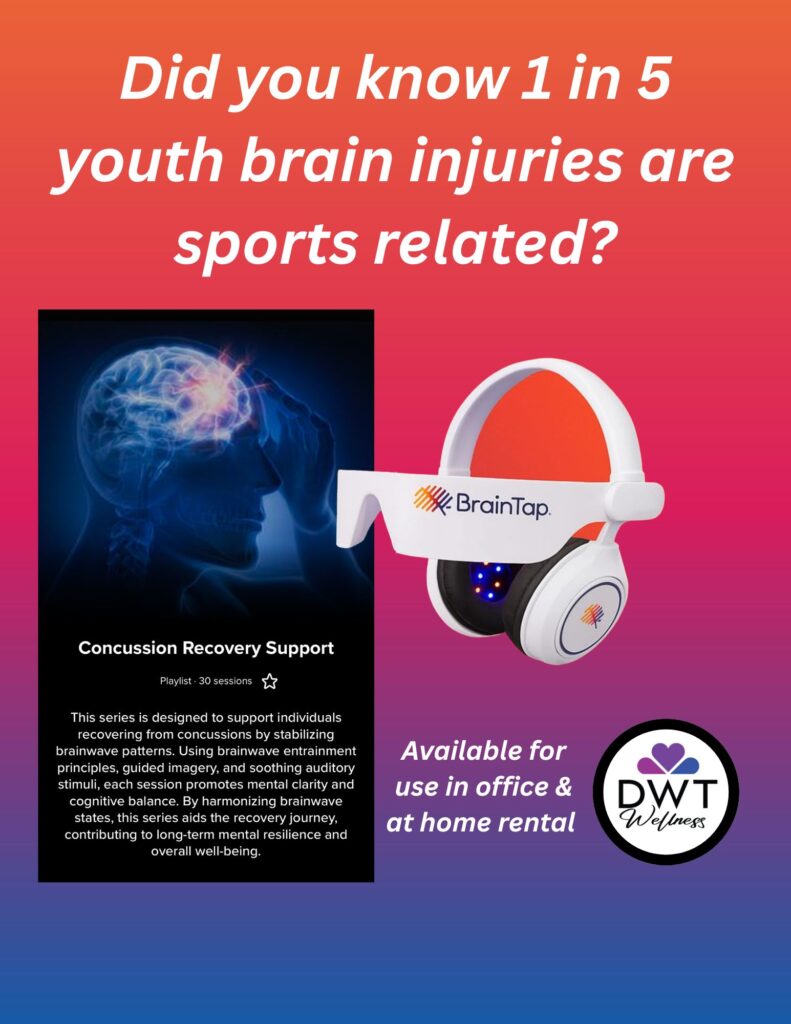
Concussions are one of the most common—and most overlooked—injuries in youth sports today. While bumps and bruises are expected on the field, a head injury is something far more serious. The long-term consequences of untreated or poorly managed concussions can be life-altering.
📊 The Reality of Concussions in Youth Sports
- Each year, over 3.8 million concussions occur in the U.S., with youth athletes accounting for a significant portion of those injuries.
- According to the CDC, sports and recreation activities account for 21% of all traumatic brain injuries among children and adolescents.
- In high school sports, football, soccer, and lacrosse report the highest rates of concussion.
- What’s more concerning? Many concussions go undiagnosed or are dismissed, putting young brains at risk of cumulative damage.
🧘♂️ Introducing BrainTap: A Drug-Free Tool for Brain Recovery
At DWT Wellness, we are committed to helping athletes recover properly and perform at their best. That’s why we’ve integrated the BrainTap system into our concussion support protocol.
What is BrainTap?
BrainTap is a cutting-edge neurotechnology that uses a unique blend of:
- Guided audio sessions (to retrain thought patterns)
- Pulsed light therapy (to encourage healthy brainwave activity)
- Binaural beats and isochronic tones (to relax the nervous system and support neuroplasticity)
Together, these elements create a powerful environment for the brain to rest, reset, and recover—especially after a concussion or head injury.
⚡ Why BrainTap Matters in Concussion Recovery
Concussion symptoms can include:
- Brain fog
- Headaches
- Difficulty concentrating
- Sleep disturbances
- Mood swings and anxiety
BrainTap sessions are designed to reduce cognitive stress, improve mental clarity, and help the brain return to its natural rhythm—something traditional treatments often overlook.
And best of all? It’s non-invasive, drug-free, and safe for teens and adults alike.
🏠 Access BrainTap at DWT Wellness or At Home
You can now experience BrainTap:
- At our DWT Wellness Studio, as part of a personalized recovery program
- At home, with our BrainTap headset rental program
Whether your athlete is currently recovering or you’re looking to add a brain health tool to your recovery toolkit, BrainTap offers support when it matters most.
💬 Ready to Learn More?
If you’re a parent, coach, or athlete looking for smart, science-backed support after a head injury, let’s talk.
📍 Visit us at DWT Wellness Studio
📦 Ask about BrainTap home rental units
📩 DM or call us to schedule your first session
Because your brain deserves recovery—not just rest.
Citations:
🧠 1. Raikes et al. (2019) – Blue Light Therapy Improves Brain Recovery Post-Concussion
In this clinical trial, participants recovering from a mild traumatic brain injury (mTBI) used a 30-minute daily session of blue-wavelength light each morning for six weeks.
🔬 Key Findings:
- Improved executive function and mental clarity
- Better sleep timing and reduced daytime fatigue
- Brain scans showed positive changes in thalamic volume and connectivity
📚 View Study
🌙 2. Killgore et al. (2017) – Blue Light Reduces Fatigue in TBI Patients
This home-based study compared daily use of blue light to yellow light in people with persistent post-concussion symptoms.
🔬 Key Findings:
- The blue-light group showed reduced fatigue and sleepiness
- The treatment was safe and effective as an at-home protocol
📚 View Study
💡 3. Naeser et al. (2020) – NIR Light Therapy May Improve Brain Microstructure in TBI
Patients with moderate TBI received transcranial low-level light therapy (tLLLT) using near-infrared light within 72 hours of injury.
🔬 Key Findings:
- Brain imaging revealed improved white matter integrity
- Light therapy was safe and feasible in the acute phase of injury
📚 View Study
🔁 4. Bajaj et al. (2021) – Blue Light Strengthens Brain Network Connectivity
This study used functional MRI to examine the impact of light therapy on the brain’s default mode network (DMN), which plays a key role in self-awareness and memory.
🔬 Key Findings:
- Blue-light therapy enhanced connectivity within this critical brain network
- Suggests potential for cognitive rehabilitation post-concussion
📚 View Study
📈 5. Hamblin et al. (2022) – Light Therapy Supports Neuroprotection (Review)
This meta-analysis reviewed dozens of animal studies using photobiomodulation (red and near-infrared light) following TBI.
🔬 Key Findings:
- Light therapy supported neuroplasticity, reduced inflammation, and improved outcomes
- Provides foundational evidence for using light-based therapy in humans
📚 View Study
